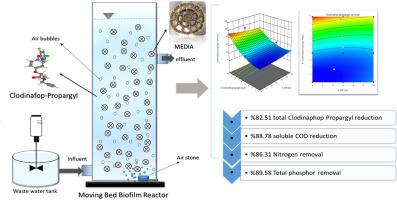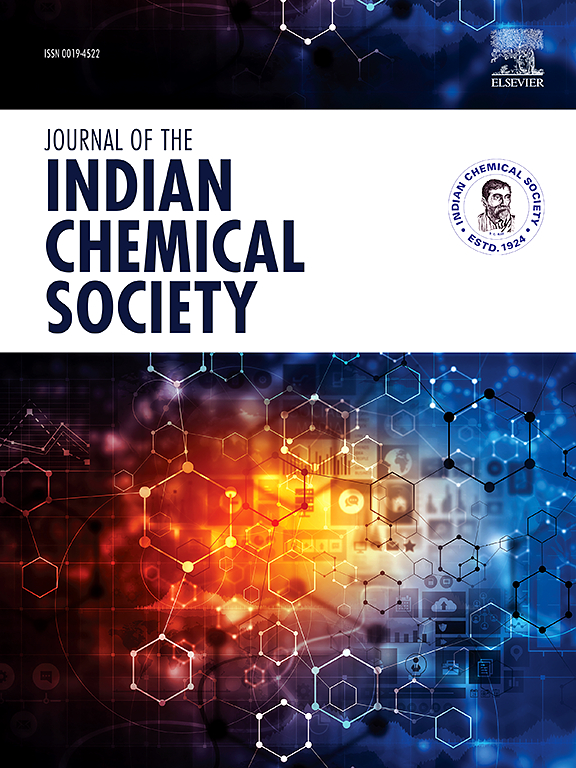减轻农药污染:利用移动床生物膜反应器(MBBR)对农业废水中的氯氟吡氧乙酸和有机负荷进行生物处理的综合研究
IF 3.2
4区 化学
Q2 CHEMISTRY, MULTIDISCIPLINARY
引用次数: 0
摘要
现代农业中杀虫剂的广泛使用对公众健康和环境构成了重大威胁。要解决日益严重的环境和经济问题,就必须采取有效的策略来清除和减轻农业毒素。本研究评估了移动床生物膜反应器(MBBR)在受控实验室环境中降解氯氟吡氧乙酸(CF)和减少有机物的效率。研究的重点是影响去除效率的关键因素 CF 初始浓度和水力停留时间(HRT)。利用 MBBR 生物反应器对 CF 进行了系统的生物降解。结果表明,CF 的最大去除率为 82.51%,化学需氧量 (COD) 为 88.78%,总磷 (TP) 为 89.58%,总氮 (TN) 为 86.31%。这些发现凸显了 MBBR 在消除废水中的化学需氧量和减少氮含量方面的强大能力,使其成为一种具有成本效益和环境可持续性的农药污染解决方案。本研究的新颖之处在于详细考察了 MBBR 在不同运行条件下的性能,为其效率和优化提供了重要见解。总之,这项研究为环境工程做出了宝贵的贡献,为处理含有农药的农业废水和支持可持续农业实践提供了一种前景广阔的方法。本文章由计算机程序翻译,如有差异,请以英文原文为准。

Mitigating pesticide pollution: A comprehensive study on the biological treatment of clodinafop-propargyl and organic load in agricultural wastewater using a moving bed biofilm reactor (MBBR)
The widespread use of pesticides in modern agriculture poses significant threats to public health and the environment. Addressing the growing environmental and economic concerns requires effective strategies for removing and mitigating agricultural toxins. This study evaluates the efficiency of a Moving Bed Biofilm Reactor (MBBR) in degrading clodinafop-propargyl (CF) and reducing organic matter in a controlled laboratory setting. The research focuses on initial CF concentration and hydraulic retention time (HRT) as key factors influencing removal efficiency. The biodegradation of CF was systematically carried out using the MBBR bioreactor. Results demonstrated maximum removal efficiencies of 82.51 % for CF, 88.78 % for Chemical Oxygen Demand (COD), 89.58 % for Total Phosphorus (TP), and 86.31 % for Total Nitrogen (TN). These findings highlight the MBBR's strong capability in eliminating CF and reducing nitrogen in wastewater, positioning it as a cost-effective and environmentally sustainable solution for pesticide pollution. The novelty of this study lies in its detailed examination of the MBBR's performance under varying operational conditions, providing critical insights into its efficiency and optimization. Overall, this research offers valuable contributions to environmental engineering, presenting a promising method for treating pesticide-laden agricultural wastewater and supporting sustainable farming practices.
求助全文
通过发布文献求助,成功后即可免费获取论文全文。
去求助
来源期刊
CiteScore
3.50
自引率
7.70%
发文量
492
审稿时长
3-8 weeks
期刊介绍:
The Journal of the Indian Chemical Society publishes original, fundamental, theorical, experimental research work of highest quality in all areas of chemistry, biochemistry, medicinal chemistry, electrochemistry, agrochemistry, chemical engineering and technology, food chemistry, environmental chemistry, etc.

 求助内容:
求助内容: 应助结果提醒方式:
应助结果提醒方式:


